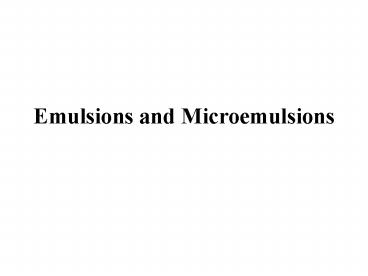Emulsions and Microemulsions PowerPoint PPT Presentation
1 / 23
Title: Emulsions and Microemulsions
1
Emulsions and Microemulsions
2
EmulsionA dispersion of droplets of one liquid
in another, immiscible liquid
- Macroemulsions (d gt 1000 nm)
- Miniemulsions (100 nm lt d lt 1000 nm)
- Microemulsions ( 10 nm lt d lt 100 nm)
3
Oil and Water do not mix !!
4
What we need for making macroemulsions ?
- Emulsifier May make it easier to form a
macroemulsion and provide stability against
aggregation, e.g. surfactants or polymers
5
Some special effects of surfactants
- Decrease of surface tension
- Control of the type of emulsion
- Droplet stabilization
6
Decrease of surface tension
- Decrease of the energy input !
7
Control of the type of emulsion
- HLB - value
- (Hydrophilic-Lipophilic-Balance)
- HLB 20 M hydrophilic part / M total
- ? For nonionic surfactants only !!
8
Droplet stabilization
- Electrostatic stabilization
- Steric stabilization
9
How one can come to small droplets ?
- Macroemulsions (d gt 1000nm)
- Mechanism of emulsification
- - adsorption
- (increase of the surfactant concentration)
- - spreading
10
How one can come to smaller droplets ?
- Miniemulsions (100 nm lt d lt 1000nm)
- - increase of the surfactant concentration
- - increase of the energy input !!
- (e.g. ultrasound treatment)
- - addition of hydrophobic agents
- (supress of Ostwald ripening)
11
Laplace pressure (? pLaplace)
- ? pLaplace 2 ? / r
- ? - surface tension
- r radius of the droplet
12
How one can come to much smaller droplets ?
- Microemulsions ( 10 lt d lt 100 nm)
- - Thermodynamically stable dispersion of one
liquid phase into another, stabilized by an
interfacial film.
13
Microemulsions
- Isotropic, optically clear
- Thermodynamically stable
- Newtonian-flow behaviour
- Low surface tension
- Reversible temperature behaviour
- Droplet size between 10 and 100 nm
- (o/w w/o bicontinuous)
14
Microemulsions are thermodynamically stable !
15
Ho Spontaneous Curvature of the surfactant film
- The most essential parameter
- of the system !!
16
Microemulsions (ternary systems)
- water, oil, surfactant
17
Microemulsions (quaternary systems)
- water, oil, surfactant
- and co-surfactant
18
Polymer induced cluster formation
19
Polyelectrolyte-modified microemulsions
- Oppositely charged PEL can be incorporated !!
- ? PEL increase the stability of the surfactant
film !!
20
Fields of application
- Microemulsions as nanosize reactor
- Microemulsions in separation processes
- Microemulsions as drug delivery systems
- Microemulsions in enhanced oil recovery
21
w/o Microemulsion I
w/o Microemulsion II
containing e.g. 1mM BaCl2
containing e.g. 1mM Na2SO4
22
Polyelectrolyte-modified microemulsions as
nanoreactors ?
PEL can control the particle growing process ???
- PEL can stabilize nanoparticles during the
process of redispersion ???
23
Isolation of polymer-stabilized nanoparticles
(patent WO2004/056928AS)
Nanoparticle formation in w/o microemulsions
Solvent evaporation
Redispersion of the polymer-stabilizied
nanoparticles

